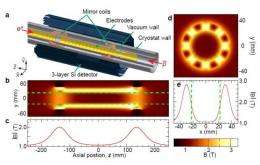May 4, 2011 report
CERN scientists confine antihydrogen atoms for 1000 seconds

(PhysOrg.com) -- Seventeen minutes may not seem like much, but to physicists working on the Antihydrogen Laser Physics Apparatus (ALPHA) project at the CERN physics complex near Geneva, 1000 seconds is nearly four orders of magnitude better than has ever been achieved before in capturing and holding onto antimatter atoms. In a paper published in arXiv, a team of researchers studying the properties of antimatter, describe a process whereby they were able to confine antihydrogen atoms for just that long, paving the way for new experiments that could demonstrate properties of antimatter that until now, have been largely speculation.
The process works by cooling the antiprotons that when combined with positrons, are used to make the antihydrogen, which reduces the energy in the resulting antimatter and allows for more of it to be confined in a magnetic trap, and then held there in a cloud for a period of time.
One of the big questions in physics is whether antihydrogen atoms occupy the same energy levels as hydrogen; others of course want to know how it reacts to gravity, as some have speculated that antihydrogen might actually fall up, or behave in other unexpected ways. The experiments going on at CERN might just answer both those questions, and more.
The idea of the specialness of antimatter has become a fixture of modern science fiction books, magazines and especially television and movies, creating in the public mind an oftentimes distorted image of what harnessing antimatter might bring. Thus, any new advances such as those happening at CERN tend to incite headlines that invite even more speculation.
At any rate, in the experiment, the researchers were able to trap 309 antihydrogen atoms, up from the previous best of just 38, which means the team is learning to both capture more of them and to hold on to them longer before collisions with various trace gasses causes them to be annihilated, or in some cases to become energized enough to escape the magnetic field.
Up next for the ALPHA team are plans to cool a small bunch of antihydrogen atoms in such a way as to allow them to watch as it either rises or falls due to gravity, thus answering one of the more exciting questions regarding antimatter, in perhaps just the next few months.
More information: Confinement of antihydrogen for 1000 seconds, arXiv:1104.4982v1 [physics.atom-ph] arxiv.org/abs/1104.4982
Abstract
Atoms made of a particle and an antiparticle are unstable, usually surviving less than a microsecond. Antihydrogen, made entirely of antiparticles, is believed to be stable, and it is this longevity that holds the promise of precision studies of matter-antimatter symmetry. We have recently demonstrated trapping of antihydrogen atoms by releasing them after a confinement time of 172 ms. A critical question for future studies is: how long can anti-atoms be trapped? Here we report the observation of anti-atom confinement for 1000 s, extending our earlier results by nearly four orders of magnitude. Our calculations indicate that most of the trapped anti-atoms reach the ground state. Further, we report the first measurement of the energy distribution of trapped antihydrogen which, coupled with detailed comparisons with simulations, provides a key tool for the systematic investigation of trapping dynamics. These advances open up a range of experimental possibilities, including precision studies of CPT symmetry and cooling to temperatures where gravitational effects could become apparent.
© 2010 PhysOrg.com




















